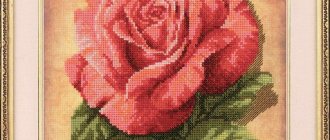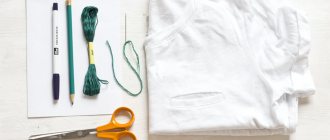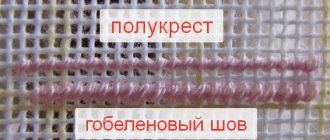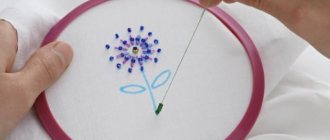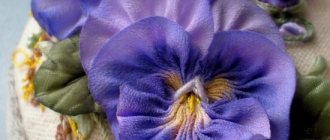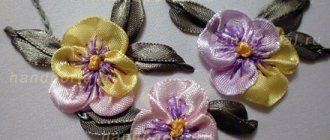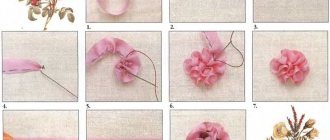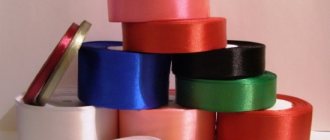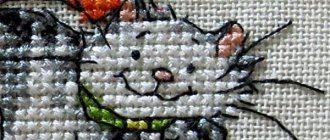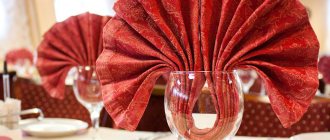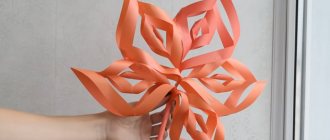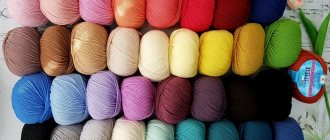Embroidery is not only one of the fascinating types of needlework, but also an original decoration for clothing. And embroidery on knitted items is perhaps the simplest and most accessible way to do this. You can easily turn any boring and simple knitted item into a bright and new outfit by decorating it with a beautiful pattern.
Embroidery on children's clothing will make it elegant, original, interesting and bright. Favorite cartoon characters, big pictures, color combinations will bring joy to your child, charge him with energy and good mood. In addition, embroidery on children's knitted items will help their development and teach them to distinguish shapes and colors, the first letters and words.
Features of embroidery
Like any other handicraft, this embroidery has its own characteristics that make clothes attractive and interesting:
- the patterns are not translated into the material. The exception is complex multi-color designs;
- Do not stretch or tighten the fabric. The structure and pattern of the material may be disrupted;
- threads are selected depending on the structure of the fabric;
- You can embroider on a knitted fabric in a hoop only if the quality of the fabric allows it.
Rough, synthetic or “loose” structure is decorated without using a hoop.
Master class on embroidering a heart on a sock
This small master class will help you quickly and easily apply a pattern to a knitted sock with your own hands.
First we decide on the place of embroidery. Using a felt-tip pen of a darker or lighter shade (depending on the color of the main fabric), transfer the heart-shaped pattern to the knitted fragment.
We take a needle with yarn and bring it onto the face into a loop in the bottom row, in the place where the pattern is indicated. Do not tighten the knot at the end of the thread. Let it remain on the wrong side; after finishing the work we will hide it.
Embroidery on a knitted product is similar to an ordinary cross, only in this case, instead of it you get a small tick or the English letter “V”, as in the photo.
This is how the whole heart is embroidered. At the final stage, all threads that lie incorrectly must be straightened and the tip hidden on the wrong side.
Read
Embroidery for newborns - metrics
This cute knitting embroidery can be used on any item: mittens, scarves, sweaters, children's dresses and other items.
Embroidery on children's things
Usually children are hostile to warm clothes; they find them unattractive. Bright pictures that will attract the baby’s attention will help to cope with this problem and change the child’s opinion, and a warm hat will become the most favorite item of clothing. Embroidery on knitted items for children is a salvation for moms and dads. The kids are warm and happy. Embroidery on mittens will keep you warm outside, and on a child's blouse - at home.
Decoration in the form of embroidery on a children's sweater will turn this banal item of clothing into a fairy-tale gift from a fairy. And on children's mittens it guarantees that the child will not pull them off as soon as the mother turns away. This is a completely individual thing that will make your child stand out from others.
Advantages of machine embroidery on children's clothing
Since children's embroidery is done on different types of materials, you can buy any clothing for its application. This decor looks very beautiful on festive outfits. But you can use this type of decoration for everyday things.
Kids are not very tidy; their clothes have to be washed often. But this will not harm the image. Embroidery for children is performed using consumables that are highly resistant to the following:
- water,
- washing powders,
- sun rays.
The decor will retain its original brightness and attractiveness for a long time. The image creation is carried out under the control of an electronic program. This guarantees high quality, reliability of stitches, absence of defects and shortcomings.
By purchasing beautiful, high-quality things for a child, a mother instills in her daughter and son good taste, which will definitely come in handy in adulthood. Embroidery is one of the best ways to decorate children's clothing. Things with such decor look stylish, sophisticated, allowing growing ladies and gentlemen to be fashionable and modern.
You can use embroidery not only for decorative, but also for practical purposes. With its help you can apply not only drawings, but also inscriptions and initials. Such embroidery for a kindergarten or sports section makes it easy to identify the owner of the item and eliminate confusion.
Qualified employees create decor using modern Japanese equipment of the latest generation, which guarantees efficiency and high quality of work.
Photo gallery
Children's ornaments and patterns for embroidery on knitted items
Do you want to please your child with a stylish and trendy inscription-logo or an image of your favorite cartoon character? Take advantage of the tips and tricks of famous stylists and designers:
- beautiful, bright letters embroidered using the “loop-to-loop” technique will surely appeal to little smart people and smart kids;
- Cartoon characters, funny animals, hearts are an excellent option for decorating children's knitted clothes;
- ornaments made of beads, ribbons, and glass beads shimmering with rainbow colors will definitely delight young ladies;
- a great New Year's gift will be knitted scarves, mittens and hats with the appropriate theme - Norwegian patterns, cute snowflakes and Christmas trees will remind you of Kai and Gerda, and Santa Claus's reindeer team on a sweater for a boy will be an excellent New Year's present;
- images of Monster High dolls or favorite princesses will be a pleasant and unexpected surprise for girls.
Working with a drawing
Ornaments look equally beautiful on everyday, sports and elegant children's products. The main thing is that the knitting of the product on which embroidery will be carried out has a uniform structure. Regarding the threads used - wool, viscose, silk, metallized are allowed. Depending on the chosen pattern, they can be combined. To give a special splendor to the product, individual embroidery elements can be decorated with beads, glass beads, sequins, ribbons or beads. There are three ways to apply an embroidery pattern to a knitted product:
- The simplest and most accessible way is improvisation. Mark the boundaries of the planned design on the canvas and start decorating at your own discretion, giving free rein to your imagination.
- Make or copy the image on transparent paper like tracing paper, then use simple stitches to sew it to the product along the contour of the diagram. Next, the paper is removed, and the outline of the design that we will embroider should remain on the fabric.
- Using non-woven fabric - a design of decoration is made on a non-woven sheet and cut out. The blank can be made either as one solid image, or all the details can be prepared separately. This scheme is steamed to clothing using an iron. Embroidery on it is usually done using double-sided satin stitch.
Schemes and samples
Complex patterns of ornaments and designs for embroidery on knitted items will require patience, great desire and certain skills. It is recommended to start with the simplest images and patterns. It is necessary to study various types of seams, master the technique of distributing stitches evenly, and understand the nuances of fabric and thread tension.
What kind of knitting embroidery might interest your child and can be done by both a novice craftswoman and an experienced needlewoman? The main activity of a child is play, which can also be reflected in embroidery on children's clothing. The baby’s imagination creatively perceives any image. For you, the Little Mermaid on a T-shirt is just a cartoon character, but for a child, it’s almost a living creature and a friend. You can teach your baby to carefully fold clothes so that the friend embroidered on it sleeps peacefully, then he will rush to put this thing on again so that the “friend” does not feel offended. Such embroidered clothes are not just a wardrobe item - they are an element of creativity and a toy.
Embroidery and finishing of coats
The variety of coats presented in stores today is impressive. Popular models deny with their appearance that the main thing in outerwear is practicality; they shift the emphasis towards beauty and originality. To create this effect, designers resort to unusual styles and non-standard finishes. It is the decor that will allow you to easily update your boring outerwear according to the latest trends. Embroidery on a coat in a studio will help you with this.
Atelier "Talisman" in Moscow will help you inexpensively develop and implement a truly unique design that will make you stand out from the crowd.
How to trim a coat
Decorating a coat is by no means a trivial task. Firstly, there are a large number of options for fashionable decor - many materials and techniques are used for this purpose. This can be embroidery or appliqué, edging with leather, braid or fur, decor with rhinestones and beads, or all sorts of combinations thereof. You need to have design skills and flair to develop a harmonious design that can decorate, and not cheapen, the item.
Secondly, the fabrics used for sewing coats (crepe, gabardine, vigon and others) are very difficult to process and can “not forgive” mistakes, become unusable and lose their appearance. In order to start decorating yourself, you need to stock up not only with accessories and patience, but also with special equipment in addition to a simple sewing machine. Considering also how much outerwear costs, we advise you to abandon experiments and contact the Talisman studio in Moscow, which will perform:
- decoration with rhinestones, beads, stones and sequins;
- machine, hand and computer embroidery;
- embroidery on a children's coat;
- leather and fur trim;
- decoration with braid, ribbons, cord, etc.
You can use felt embroidery and appliques on felt on a coat - these are fashion trends today.
Work on an order begins with developing a design together with the client - the master will help you decide on the style, finishing technique and necessary fittings on site. Next, the item enters the production workshop, equipped with modern equipment that works with the most complex materials. You can find out how much satin stitch embroidery on a coat costs in Moscow from a specialist at a branch or by phone.
Price
The price for finishing is available and is discussed when accepting the item at the order table. It is calculated based on the complexity of the technique and materials of the work. Examples of our work and prices can be found on the website (see photo and price list on the page), as well as during a free consultation with a specialist.
Types of embroidery stitches
How to do embroidery on a knitted product and what special types of stitches and techniques to choose? Many needlewomen ask this question before starting work. To ensure that the selected design looks appropriate and the finished work pleases you, choose one of the types of embroidery stitches offered below.
- Cross stitch - cross stitch on knitted fabric is done in the same way as on regular fabric. That is, by pulling the thread diagonally.
- Loop in the attachment - a thread is threaded in the center of the future design. Several loops are retreated depending on the size of the element and displayed. The thread is wrapped around the needle once, threaded through the fabric and brought out in the center of the design. Such manipulations are performed with all elements. Typically, this method is used to embroider flowers on a knitted product.
- Hemstitching - this decoration option is one of the simplest. The thread is fixed at the top of the desired loop. The needle is pulled under two and over two threads so that they twist together around the thread.
- Openwork holes - such needlework is created by processing the holes of a knitted product with double-sided stitches. It looks very beautiful, especially if you use a contrasting thread for work.
- Swiss embroidery is stitch embroidery on knitted items. The pattern turns out to be very similar to a knitted one - and this is the peculiarity of this type. Only upon careful examination can one discern that it is embroidery. Almost any image can be done this way. This method significantly thickens the finished knitted product and is often used to additionally secure elements of children's clothing. For example, elbows in a sweater and knees in pants.
- Knot - for this method, the thread is secured in the appropriate place. A needle is inserted onto the front side and two or three turns of thread are wound around it. Then the needle returns to the wrong side where it was pulled through.
- Rococo - this decoration is made on the front side. A thread is secured without a knot and pushed through the loop several times. The needle is pulled through the fabric. Several turns of thread are thrown onto it. The needle is pulled out through a spiral held with a finger.
- Honeycomb - this embroidery requires pulling the thread through two loops, which are located at a certain distance from each other. Then wrap this area two or three times with thread and tighten it tightly. Thread the needle up and down and repeat the manipulation.
Embroidery methods on knitted fabric
Let's consider the commonly used methods by which decorative needlework is carried out - embroidery on knitted products.
Hemstitch
You need to attach the thread to the top of the open loop. We insert the needle first from below under a pair of stretched broaches, and then from above. The next step is to turn it over in order to twist two pairs of broaches, one with an arc near the thread. We continue to work according to this scheme.
Read
Embroidery signs for fulfilling your most cherished desires
Embroidery around the patterned hole
Knitted gaps in the fabric can be decorated with edging threads of a contrasting shade.
Rococo"
Wonderful French Rococo embroidery, ideal for knitted items, it looks especially cute on children's things.
It is necessary to insert and remove the needle and thread through the knitted material from the front part. Make a couple of turns of the thread around the needle. Holding the resulting turns, we insert the needle, as the diagram shows us.
"Loop to Loop"
This seam is used to completely hide the loops of a knitted product. It can be performed on the wrong side, as well as on the front side in one of two directions: horizontal and vertical.
To embroider in a horizontal direction, you need to fix the thread on the wrong side. We bring the needle to the face through point A (point “A”) and stick it into the next one (point B - point “B”) under the base of the upper loop and pull the thread at point C (point “C”). Let's fix it. Next, we insert the needle at point D (i.e. “D”) and pull it out at point E, in preparation for embroidering the next loop.
To embroider in a vertical direction, fix the thread and pull it from the wrong side to the face (i.e. “A”). We stick into point “B” and push it into point “C”. After this, we make a broach under the loop, which is located below, and bring the material to point “D”.
To embroider horizontally on the wrong side, fix the material and bring it to point “A” across the base through point “B”, pull it and bring it to point “C”. Through point “D” we bring the embroidery to point “E”. Repeat the next loop. We stick a needle into point “D”. We finish the embroidery starting from point “F” under the base of the final loop. Next, we pull it through the top row to point “G”.
To complete the embroidery, insert the needle into point “F” under the base of the last embroidered loop and pull it through one row from above to point “G”. When doing work from the left to the right side, you need to hold the needle across and thread it into point “H”, bringing it out to point “J”.
The diagrams provided show the exact order of all the steps described.
Read
Multi-plot motifs in sampler embroidery
Swiss style embroidery
This handicraft involves embroidery on knitted fabric using a loop-to-loop stitch. Using this method, it is much easier to add contrasting colors to a plain product rather than knitting a pattern. This option is used for embroidering delicate compositions on a dark background, for applying complex geometric patterns, floral patterns and symbols. Each element presented in the diagram can be applied with such a seam.
Swiss embroidery differs from knitting only upon closer inspection. It increases the density of the fabric. Therefore, it is often used on the elbows and knees of products.
Cross
Cross stitch on knitted fabric is similar to embroidery on fabric. Crosses help create a variety of patterns. The stitches should lie close, but not tightly, so as not to pull the knitting. The action plans are as follows:
Method "Honeycomb"
This technique imitates puffs based on the material used. This type of handicraft is used to frame edges and necklines, and gives additional volume to products. Embroidery is done to match the knitting or in different colors. The embroidery process is presented step by step in the diagrams.
Before starting work
Before you start working on embroidery on a knitted product, pay attention to the following few rules:
- Inspect the item you plan to work with. Determine the thickness of the yarn used in it. When embroidering with a thread that is too thin, you may end up with a sloppy design that will not hide the threads of the product. And a pattern embroidered with too thick yarn will look untidy.
- Choose the right needle. It should not be very thin, blunt-ended and with a large ear. Such a needle will easily pass through the product without spoiling its structure or clinging.
- Try not to tighten the loops of the product itself too much while working, otherwise you will end up with a damaged, shapeless and tight item.
- To prepare an item for decoration with embroidery, it is recommended to moisten it with water and then let it dry. This technique will align the loops and ensure good quality of the pattern.
